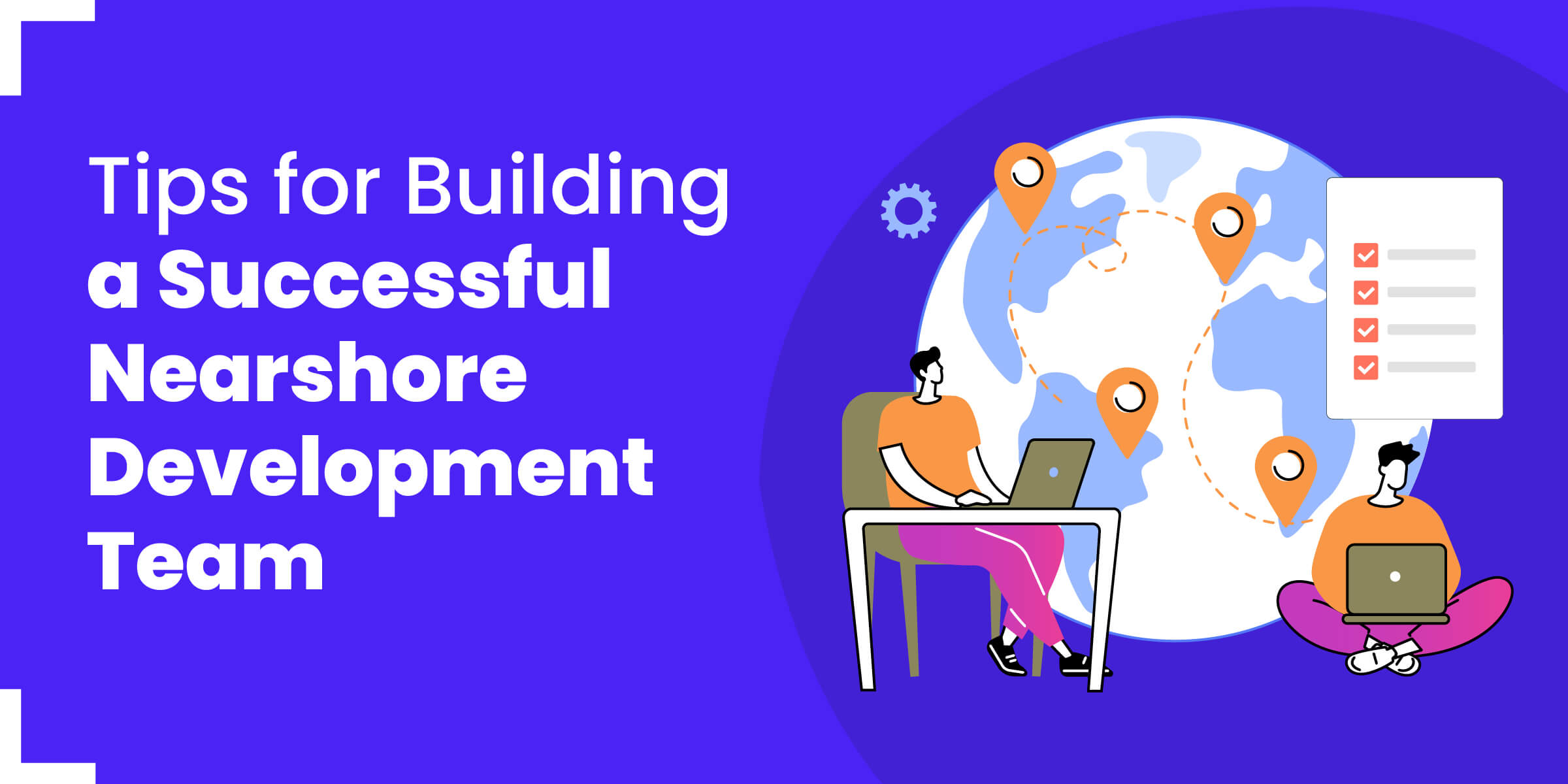Building an outsourced software development team but slightly limited on budget and don’t know where to start?
You have three options: onshoring, offshoring, or nearshoring.
Nearshoring offers the best of both worlds. It combines the benefits of onshoring, like high-quality developers in a similar time zone, with the cost-saving benefits of building an offshore software development team.
Here’s how to take advantage of this increasingly popular outsourcing model.
We offer this website completely free to our visitors. To help pay the bills, we’ll often (but not always) set up affiliate relationships with the top providers after selecting our favorites. However, we do our best not to let this impact our choices. There are plenty of high-paying companies we’ve turned down because we didn’t like their product.
An added benefit of our relationships is that we always try to negotiate exclusive discounts for our visitors.
Why We Like Toptal
Tips for Succesful Nearshore Development


1 – Understand Your Needs
The first thing you’re going to need to do when creating a nearshore development team is to figure out what exactly you need from the team.
Prepare for your search with a strategic vision and create a roadmap detailing what you want your team-building journey to look like.
Create a list of non-negotiable qualities you need in your development team, including considerations for budget and size of the team. A few qualities you can look for are:
- Effective communication skills
- Country of origin
- A track record of positive reviews across multiple sites
- A proven history of successful projects
- A fractional or full team, or a freelancer
- Industry-specific knowledge and experience
Define clear goals regarding deadlines and other quantifiable metrics. Set expectations. Then start your search.
2 – Search for Quality Candidates
Now that you have your specifications, start your search.
Filter companies based on your budget and your list of desired qualities. Now is a good time to decide if you want a smaller or larger team and really hone in on exactly what you’re looking for.
If you want to make it easy on yourself, have someone else do the legwork for you. Toptal will meet with you and get an idea of what you’re looking for, then match you with a shortlist of qualified, vetted candidates. Toptal only accepts the top 3% of developers who apply, so you can count on quality.
Read reviews on sites like G2, Clutch, and Crowd Reviews to see what other clients had to say about them.
3 – Review Developer Portfolios
Look at each developer’s portfolio to gauge their abilities and experience.
You’ll ideally want to find a team of developers that has experience in an industry similar to yours so that they’re familiar with niche-specific components of development.
4 – Interview Shortlisted Candidates
When you have narrowed down your options based on credibility, portfolio, and price, interview your shortlist.
A unique challenge that doesn’t come with onshoring developers is a possible language barrier. Ensuring that your development team is fluent in your language is essential for effective communication.
Make sure you interview the developers on the team that you will be interacting with daily to gauge whether you will have a good working relationship.
Take the time to ask thorough questions about their experience, how they overcome challenges, and their specific approach and processes to make sure they align with your vision and goals. You want a partner who will think strategically and contribute new ideas to your product, not just do whatever you say.
5 – Craft Agreements
Before you build your team, carefully outline the terms of your agreement, including things like pay and access to data, including legal factors.
Have a legal team review these contracts before signing them:
- Master Services Agreements (MSAs) establish the foundational framework for governing future projects. It must include confidentiality, intellectual property rights, payment arrangements, liability constraints, and other critical provisions. An MSA essentially eliminates the need to create new terms for each individual agreement. If you do end up needing to outline precise terms for individual projects, Service Level Agreements (SLAs) come into play.
- Service Level Agreements (SLAs) define precise criteria and expectations for a particular project or a series of projects.
- Non-disclosure agreements (NDAs) serve as protective measures for your company's confidential information in case your nearshore partner may collaborate with competitors in the future.
Creating specific agreements eliminates confusion or miscommunication later in the relationship and ensures a fair deal for both parties.
Share your vision and your plans for your product with your development team to get them on the same page. This helps them understand where you’re going so that they can get you there.
If you have an in-house development team that already has processes in place, make sure they communicate these protocols to your nearshore development team.
7 – Facilitate Communication
Facilitating regular communication between in-house employees and nearshore development teams is essential to keep everyone working toward the same goal.
If financially possible, have everyone meet face-to-face every once in a while. If not, a group video call is a great way to build a sense of community and encourage continuous communication.
8 – Effectively Build Your Team
Collaborate with your outsourcing partner to strategize the formation of an optimal nearshore team that combines cost-effectiveness with efficiency. Engage in open discussions regarding technology stacks, skill sets, team sizes, and project delivery timelines.
Include a Quality Assurance (QA) engineer in the team to ensure thorough oversight. The QA engineer will be responsible for designing comprehensive testing protocols to detect and address software issues well before product launches or the introduction of new features. They will also create and execute fresh testing procedures, providing feedback to the engineering team.
As your partnership with your nearshore collaborator progresses, stay open to exploring different team structures. Over time, your collaboration should evolve into a well-coordinated operation, yielding high-quality software like an in-house team, even while working remotely.
Find out more tips for how to build a quality team from these helpful nearshoring case studies.
Tips for Selecting the Right Country


With all of your nearshore options, selecting the right country to source your development team is a difficult, though important, place to start your search.
Consider these factors when selecting your desired nearshore location:
- Time Zones: Choose a nearshore country with a time zone that allows for easy communication and collaboration with your in-house team.
- Cultural Compatibility: Evaluate the cultural compatibility of the nearshore country. A shared understanding of work ethics, communication styles, and business practices can foster smoother collaboration.
- Tech Ecosystem: Look for countries with a strong IT industry, a pool of skilled developers, and a history of successful outsourcing.
- Language Proficiency: Ensure that the workforce in the chosen country is proficient in the language you prefer for communication.
- Legal and Intellectual Property Considerations: Review the legal framework and intellectual property protection in the nearshore country to ensure that your intellectual property rights are safeguarded.
- Cost: Compare the cost of outsourcing in different countries. Take into account labor costs, taxes, and other overhead expenses.
- Political and Economic Stability: Assess the political and economic stability of the country as instability can lead to disruptions in your project.
- Time-to-Market: Evaluate the speed at which you can set up your outsourcing team in the chosen country. Quick setup can help you get your project off the ground faster.
- Client References: Ask for client references from outsourcing providers in the country to get insights into their performance and reliability.
- Visit in Person (if possible): If you can, visit the nearshore country and meet with potential outsourcing partners. This can provide valuable insights into their capabilities and working environment.
- Scalability: Ensure that the chosen country can provide the scalability you may need in the future as your project grows.
- Data Security and Compliance: Verify that the nearshore country complies with international data security and privacy regulations, especially if your project involves sensitive data.
Tips for Building a Successful Nearshore Development Team


Here are some additional quick tips to improve the process of building a nearshore development team to prevent common nearshoring challenges.
- Establish Effective Communication: Establish clear communication channels and tools to facilitate seamless collaboration between your in-house team and the nearshore team. Regular video meetings, messaging platforms, and project management tools help.
- Cultural Alignment: Foster cultural alignment by understanding and respecting the cultural nuances of your nearshore team. Encourage open and transparent communication to bridge cultural gaps.
- Start with a Small Project: Consider starting with a small, well-defined project as a trial to evaluate capabilities and compatibility before committing to a long-term engagement.
- Define Roles and Responsibilities: Clearly define roles and responsibilities for both your in-house team and the nearshore team members to avoid confusion and overlap in tasks.
- Emphasize Quality Assurance: Place a strong emphasis on quality assurance by incorporating regular code reviews, testing, and quality control processes into your development workflow. Consider including dedicated QA engineers.
- Monitor Progress and Metrics: Implement performance metrics and Key Performance Indicators (KPIs) to track the progress and success of your nearshore team. Regularly review these metrics and adjust as needed.
- Bonus Tip: Foster Team Integration: Promote a sense of integration and camaraderie between your in-house and nearshore team members. Encourage team-building activities, cross-cultural training, and regular interactions to build trust and collaboration.
Best Place to Find Qualified Nearshore Developers


Toptal is our top recommendation to find qualified nearshore developers. They only hire the top 3% of development talent, vetting nearshore developers thoroughly so you don’t have to.
Toptal will streamline the team-building process for you, providing you with top talent in a fraction of the time it would take to search on your own.
Why We Like Toptal
- Top Talent: Get access to elite, pre-screened candidates (only accepts the top 3%)
- Flexibility: Ideal for long-term or shorter-term specialty projects
- 14-Day Risk-Free Trial: Only get billed if you're satisfied
Frequently Asked Questions
What makes a strong nearshore development team?
Communication, experience, industry expertise, technical skills, and shared values make a strong nearshore development team.
Which countries should I look for nearshore development team members?
You should consider countries like Mexico, Colombia, Nicaragua, Costa Rica, and Brazil for nearshore development team members.
Where should I look for qualified nearshore developers?
You should look for qualified nearshore developers on Toptal, or use a larger site like Upwork for businesses with smaller budgets.
How much does it cost to build a nearshore development team?
Though the cost varies depending on the country, expertise, and scope of the project, it costs anywhere from $5,000 to $25,000+ per month to build a nearshore development team.
How can I create a nearshore development team?
You can create a nearshore development team by setting your goals, searching for development talent, doing your research to create a shortlist of candidates, thoroughly interviewing candidates, and crafting agreements to ensure a successful partnership.



















